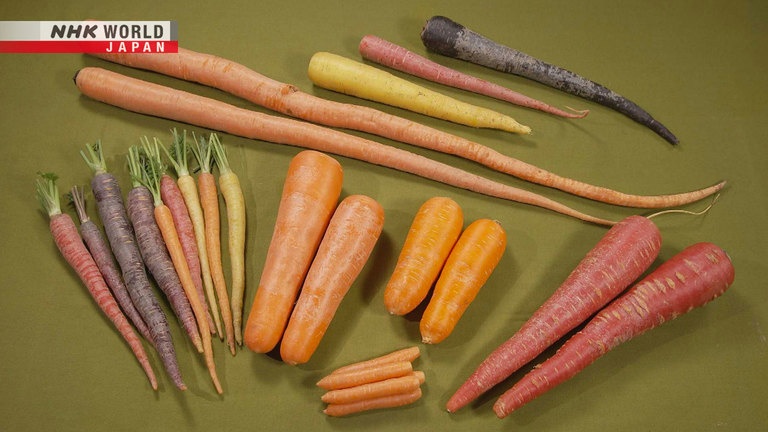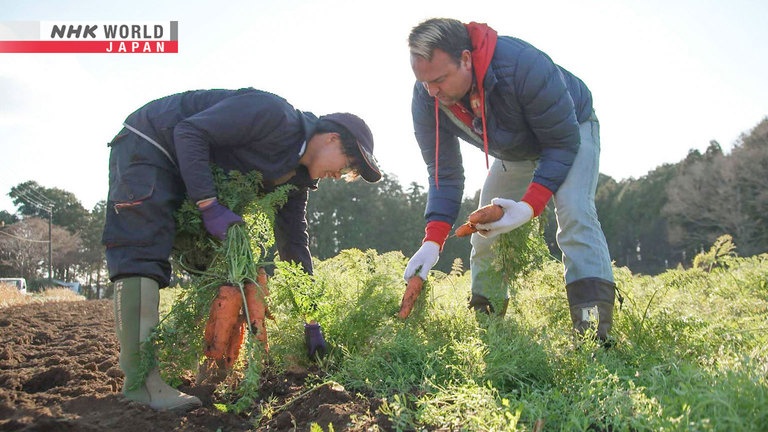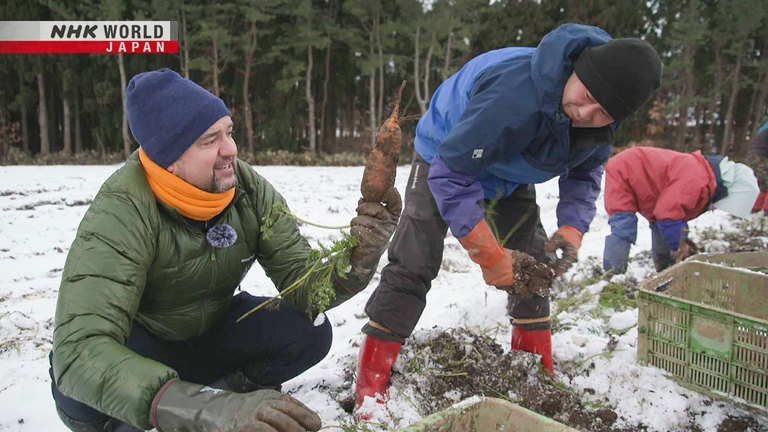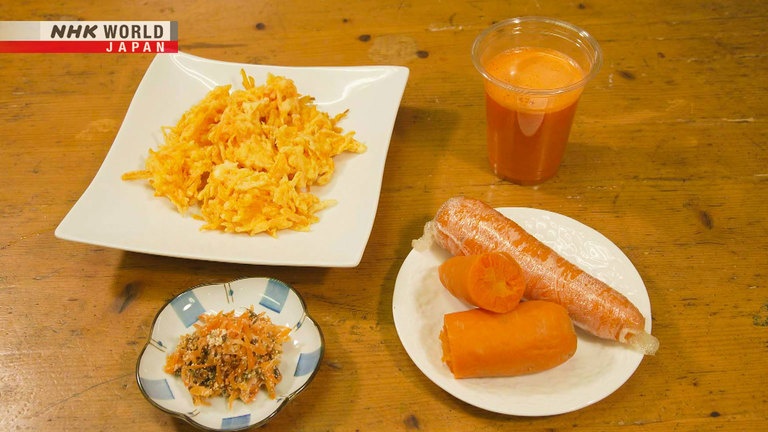CARROT
Japan has a number of carrot varieties resulting from selective breeding. Discover carrots grown beneath the snow and savor an array of dishes from French to Japanese. (Reporter: Jason Hancock)




Transcript
Tokyo: this world-class metropolis is a veritable gourmet wonderland.
Discover the stories behind the ingredients that make this city so delicious-so "oishii."
This time, it's all about carrots.
Tasty anyway you prepare them, carrots are a staple in almost any household.
The part we usually consume is actually the root.
I've never seen one this big!
The orange root is rich in nutrients like beta-carotene, potassium, and dietary fiber.
Most carrots are chunky and orange, but they come in other shapes and colors too.
Red is a celebration color...
Making some carrots a perfect choice for New Year's dishes.
Dig in to see how Japanese carrots are evolving into sweeter, tastier vegetables.
Trails to Oishii Tokyo.
Hello, everyone. I'm Jason Hancock.
On this episode, we are going to learn more about carrots.
I love Japanese carrots; they are very sweet and delicious,
and I actually always carry them in my bag as a snack.
I'm very curious to know why the Japanese carrots are so delicious.
Let's find out together.
Our American reporter Jason visits Toyosu Market at the end of the year.
This wholesaler handles a variety of produce, from traditional veggies to herbs.
At this time of year, ingredients for New Year's dishes are on prominent display.
Yuzu, so good. Lemons...
Here are the carrots.
Really good carrots.
- Good morning.
- Good morning.
Meet Kondo, a wholesaler with around 40 years under his belt.
These look really nice.
That's the most popular variety in Japan.
Where are they produced?
- These are from Chiba.
- Chiba! Nearby.
Carrots are harvested from fall to winter.
Ones near Tokyo are in season right now.
The most common type of carrot in Japan is called Gosun.
It's 15 to 20 centimeters long.
Carrots are a common, high-demand ingredient.
Varieties and cultivation methods differ each season,
as farmers around Japan pass the baton to allow for a year-round supply.
Originally, they were only in season from fall to winter, as they're sensitive to heat.
Winter carrots mostly come from Chiba, next to Tokyo.
I'm familiar with this type.
These other ones are carrots too?
That's right.
I've never seen one this long
and with this color.
- Lovely, right?
- Very. A red carrot?
- It's called Kintoki.
- Kintoki?
In Kyoto, it's called Kyo-ninjin,
after the old capitol.
- It's a popular choice
for festive New Year's dishes.
- I see.
So, they're only produced
at the end of the year.
Kintoki are sweet, and red to the core.
The red comes from lycopene, which is in tomatoes as well.
It makes them perfect for traditional New Year's dishes like osechi.
This is kohaku namasu.
Shredded kintoki and daikon radish are pickled in vinegar and sugar.
The ingredients offer a mix of red and white, the colors of celebration.
Here, carrots are made to look like plum blossoms.
Plum blossoms appear before other flowers in early spring despite colder temperatures,
so they symbolize strength and vitality.
Are the red and orange ones the same variety?
Not the same. Roughly speaking,
orange is Western, red is Eastern.
Carrots are thought to have spread east to west from their birthplace, Afghanistan.
Long carrots may have come to Japan from China around the 17th century.
Back then, carrots came in all kinds of colors-red, yellow, purple,
and even white - some of which have become popular again in recent years.
The shorter, orange carrot came to Japan around the 19th century.
Since then, selective breeding has led to many sizes and colors.
Carrots are getting sweeter and sweeter.
- They weren't this sweet before?
- No.
I'm ready to learn more!
- Have fun.
- Thank you.
Now fully intrigued, it's time for a trip!
Jason heads to Chiba, the largest production area of winter carrots.
About an hour drive takes him to Yachimata, in northern Chiba.
Yachimata is Chiba's carrot leader.
Soft, fine soil made from volcanic ash offers a suitable environment for growing carrots.
Very beautiful and green.
- Hello.
- Hi.
These are big!
It's been a warm year,so they got big.
I've never seen one this big!
Welcoming Jason is Misu Hiroyoshi.
He's the 13th-generation farmer here.
He and his son, Shota, grow three types of carrots on a 10,000-square-meter field.
Do you both come early in the morning?
We do different work in the morning.
Digging is mostly from the afternoon.
- Why is that?
- Carrots absorb water and grow at night.
Harvesting in the morning will break them,
because they are still moist.
It's better to wait until the afternoon.
Very juicy.
Carrots are about 90% water, making them quite delicate.
Farmers can tell which ones are good just by looking at them.
Look at these two.
The one with a thinner core is tastier.
Thin is better?
A thicker core means the carrot grew for too long.
A thinner core means the carrot is less fibrous, with a deeper flavor.
In addition, a rounder tip means it's perfectly ripe,
meaning it's much tastier than the pointy one.
- This is fun.
- Yeah?
Easier to pull up than I thought.
It's easy because Misu puts a lot of work into prepping the soil.
Before planting seeds, he digs trenches to break up and soften the soil.
It's tough, but it
makes things easier later.
It also provides better drainage,
so the carrots turn out better.
Interesting.
He uses organic, mineral-rich fertilizer to promote the growth of microorganisms.
Mixing excess leaves helps keep the soil rich too.
- How do you deal with pests?
- Pests? The moon.
Moon?
Up there?
- Bugs lay eggs during a full moon.
- Is that right?
Days before a full moon, he sprays the fields with microbial solution that's safe for natural farming.
The method follows the lunar calendar, and is meant to control pests during high tide,
which occurs during full or new moons.
This way, pests can be controlled with fewer chemicals.
Moths and butterflies damage carrots.
In school, I learned when bugs
lay eggs during the lunar cycle.
I figured preventing them from
laying eggs would improve the carrots.
- Farming in synch with the weather,
as well as the moon's cycle?
- Exactly.
Amazing.
Shota studied insect ecology at agricultural school.
He researched pest control in carrot crops using endangered Japanese toads.
These efforts in organic farming and species preservation won him an award.
- Protecting nature with nature.
- Right.
Amazing. So cool.
Misu and his son are passionate about carrots.
They're also trying to grow some rare varieties.
You grow here too?
Yes, different carrots.
How are they different?
Wow! It's the color of corn.
This is a variety called Kinbi.
Kinbi are best eaten raw, like in a salad, because they're soft with dense sweetness.
It's only like this if you
harvest it in December.
In January, when it's colder,
it gets bruised and darker.
- The time is now.
- Exactly.
A father and son's knowledge and experience go into the carrots' development.
Now, it's time to try some!
Chiyoko, Misu's wife, will whip something up.
She'll make some carrot juice first.
No additives in the juice, just carrots.
He tries the one with a deeper color first.
Should have a strong carrot flavor.
- Sweet, right?
- This is unbelievably sweet!
Like apple or watermelon juice.
So good!
Next up, Kinbi.
It looks like mango juice.
The sweetness of the carrot
has much more presence.
It's the taste of happiness.
Cook it, and it becomes even sweeter!
These are the best carrots
I've had so far.
Thank you. That's great to hear.
What kind of carrots
do you want to grow next?
I just want us to keep
improving the quality.
I'm blessed to be able to work with my son.
Sweet and tasty carrots are homegrown with combined experience and knowledge.
The passion of this father-son enterprise in Chiba opened Jason's eyes
to a whole new world of carrot possibilities.
Tasty carrots can be grown in even colder and snowier regions too.
Jason leaves Tokyo on a three-and-a-half-hour journey by plane and car.
He arrives in Fukaura on the western coast of Aomori in northern Japan.
The Shirakami-Sanchi mountain range is a UNESCO World Heritage Site.
Mountain streams feed nearby Fukaura with minerals, allowing fishing and agriculture to thrive.
Jason will visit a cooperative based on a plot that overlooks the Sea of Japan.
- Good morning.
- Welcome.
I heard you have carrots
that are sweet like fruit.
Where are they?
In the field just over there.
Leading Jason to the field is Niioka Shigemitsu.
Here we are.
This is just snow...
A field covered in snow.
No sign of carrot life.
Try digging.
Where are you?
- Oh, here?
- Yes!
A boy comes to the rescue with a shovel.
There we go.
- This?
- Yes.
It's a carrot!
They're under all this snow.
- This is all carrots?
- The whole field.
From here, all the way to the windmill.
Carrots are planted the whole way.
Carrots damage if they freeze, so something special has to be done before snowfall.
- You only see leaves, right?
- Yeah, no carrots.
- In the fall, we cover them with soil.
- Soil?
Yeah, about 1-2 centimeters thick.
That keeps them from getting wet.
- It's like a blanket.
- I see!
Seeds are planted in July and August.
Carrots take three months to grow before they can be eaten.
However, the carrots won't be harvested just yet.
They use a tractor to blanket all the visible carrot tops with soil -
everything is buried except for the leaves.
This keeps the carrots cold without allowing them to freeze and go bad.
Interesting!
To survive cold temperatures, carrots convert starch into sugar.
You guessed it - this makes them sweeter!
Take a bite.
"Itadakimasu."
It's really sweet.
Sweet like an apple...
or a persimmon.
Right?
This is our unique farming method.
Preserving vegetables in the snow is a traditional method with lots of history in Japan.
Growing carrots in the snow began around 20 years ago after a mishap.
One year, due to a delayed radish harvest, the fields got covered in snow
before farmers could begin harvesting carrots.
Farmers assumed they'd lost the carrots,
but they somehow survived, and tasted sweeter and less bitter than before.
And so the sweet carrot of Fukaura was born.
They continued to experiment, leading to the development of their famous local carrot brand.
After loosening the soil with a tractor, harvesting is done by hand.
Two tons of carrots are picked each day from a 300,000-square-meter field.
Harvesting is done every day, from dawn to dusk, in the bitter cold, from late-December to March.
- What's the hardest part?
- My back always hurts.
So big!
Niioka will show Jason some good ways to enjoy the snow carrots.
Shredded carrots are mixed in flour and egg, and deep-fried to make tempura.
I love tempura!
The carrots are soft and sweet.
It's almost like carrot bread.
This dish offers an additional flavor, from the sea.
Simmer boiled carrots with cod roe and nori seaweed.
Then add some soy sauce.
This makes full use of local ingredients from the nearby sea and mountains.
The sweetness of the carrots
and the roe mix nicely together.
Lastly, wrap an unpeeled carrot in plastic wrap and pop it in the microwave for 10 minutes.
It's like a sweet potato.
As a healthy snack, or even for dessert.
- You seem very happy.
- Of course!
Because people enjoy what we make.
Also, snowy regions don't offer
a lot of work opportunities.
If we keep making prized carrots,
workers can stay busy from winter to spring.
I want to keep that going.
My passion is growing snow carrots
for everyone to enjoy.
I want to do this as long as I live.
Carrots and farmers, surviving a harsh winter, together.
The result is a wonderfully sweet carrot that's become symbolic to the region.
Jason's final stop is Daikanyama, Tokyo.
On one of the many streets lined with fancy shops,
and popular places for foodies, lies a certain French restaurant.
- Hello.
- Welcome.
- I hear you have tasty carrot dishes.
- This is the place.
Owner chef Nakada Koichiro honed his skills at top French and Japanese restaurants.
In winter, he uses specialty carrots for a rice dish cooked in a clay pot.
Today, he bakes Fukaura snow carrots in the oven for two hours.
Cooking them slow condenses the sweetness and flavor.
I sear the outside a bit
to add a savory aroma.
Carrots are the focus today.
Paired with the carrots is tender chicken breast that was marinated in sweet sake.
A scoop of bright-orange salmon roe goes over a rich miso sauce.
- Why do you think I use salmon roe?
- No idea.
- Foods of the same color go well together.
- Is that right?
It's the same shade of orange, right?
That means carrots goes well
with salmon, and oranges too.
But I'll add yuzu citrus peel
for some aroma.
Now he'll fry up some carrot leaves.
The leaves taste good too.
- With carrots, nothing goes to waste.
- I see that.
- Even the skin.
- You didn't peel it.
Finished.
- Beautiful. Eating it feels like a waste.
- No, it's the opposite.
An elegant dish using all parts of the carrot.
First, the star of the day!
Sweet!
Right? The flavor is condensed.
You baked it for two hours,
but it's still quite juicy.
They store flavor and moisture
while growing in the snow.
They don't dry too easily.
Really amazing.
Sweet carrot and savory salmon roe are a match made in heaven.
- I'll make a Mont Blanc dessert
using carrots instead of chestnuts.
- Really?
Nakada purees carrots that were baked for two hours like before.
He mixes that with rich cream cheese.
- Cream cheese?
- Yes.
It's great with spices, so I'll add
cardamom to vanilla ice cream.
Cardamom, which is often used in curries, is mixed with vanilla ice cream.
Over that, he squeezes the carrot and cream cheese mix.
That's topped with carrots that were simmered in orange juice -
again, ingredients of the same color.
Both my mind and mouth are blown.
- The cardamom is very refreshing.
- Right.
I didn't know so much
could be done with carrots.
They're amazing.
Carrots aren't usually the main ingredient.
But cooking them in certain ways
offers different flavors.
They can provide a nice broth.
And everyone is familiar with carrots.
People expect a certain dish or flavor,
so using carrots differently can be surprising.
Being able to move people like that
makes it a fun and meaningful ingredient.
Carrots - the everyday grocery item.
Well, not quite...
On this journey, Jason met with passionate farmers
who've turned the humble veggie into something oh-so-sweet.
And skilled chefs take it a step further, highlighting the carrot's unlimited possibilities
with inspired dishes that bring out its unique flavor.
In Tokyo, every ingredient has its own story.